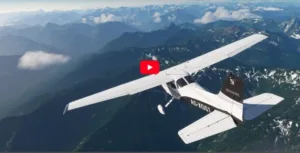In case you missed it, Flight Sim 2020 pre-alpha press event, this past week is rocking the game, flight simulation, and virtual reality worlds as Microsoft is pulling out all the stops in reviving a tried and true platform that helped launch the one-time start-up some 40 (yes 40 years wow!) ago.

With roots that pre-date even Microsoft Windows, and at 30 years old, back in 2002, Flight Simulator was the oldest game app shipping. Now a full 18 years later, the company sees a convergence (alignment) of technology, required to bring the next generation of simulation back to the home screen with as yet unseen technology advances that deliver unparalleled effects, and, remarkably, work with off the shelf components.
Powered by satellite data and Microsoft Azure artificial intelligence, the new flight simulation package will leverage the company’s Bing maps data set to deliver access to the entire planet, Yep – 197 million square miles of terra-firma, some + 2 million cities and + 40,000 airports, from obscure regionals, to mighty international hubs. Azure AI will help stream landscapes in from the cloud – that’s two petabytes of geographical information. Plus there will be real-time atmospheric conditions that will directly affect in-flight conditions. Dang!
The news hit with an announcement from Microsoft at E3 in Los Angeles in June, but the real buzz began last week with a pre-Alpha demonstration to limited press (no I was not invited… Dang!) It included first, a real flight over the tony (fashionable – ed.) neighborhoods of Renton, WA, in a Cessna (72SP) Skyhawk, then a full hands-on demo with the same plane and same airport to give an accurate baseline to compare “real” vs. the computer generated virtual experience. (Impressive!)
Microsoft Flight Simulator 2020 (FS2020) pre-Alpha press preview rocks the Simulation, Game, and Virtual Reality space with unseen technology convergence, Source: Microsoft
“The results are stunning,” said Charlie Hall, one of the lucky ones tapped by MS to cover their pre-alpha event in Redmond, WA.
“New York City looks nearly indistinguishable from the real place. Flying into Chicago’s O’Hare Airport, passing the skyline and making the big, left-hand turn on final approach is a trip I’ve made dozens of times over the years. It looks incredible, especially at night with thousands of lights…”
he wrote in Polygon this past week.
Microsoft decided to get back into the space, after two mis-starts, (Microsoft Flight 2012) and Flight Sim World (2017) that were primarily licensing deals the software behemoth cut with game developer studios, to limited success.
So the convergence of technology including powerful off the shelf displays, and processors cloud based streaming, A-I married to real-time weather data is creating a renaissance in home simulation. And if there is any doubt to the virility of this new simulation engine, it was reported that a whopping 60% of the Microsoft Flight Simulator 2020 staff that developed the software got their pilots licenses during the course of making the software – Ha! Happily, the revival of an early day Microsoft mainstay is coming in 2020, (and hopefully in time for Christmas – yes?) – Stephen Sechrist

